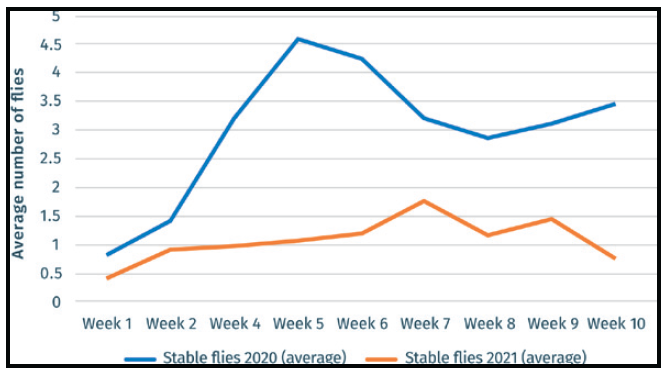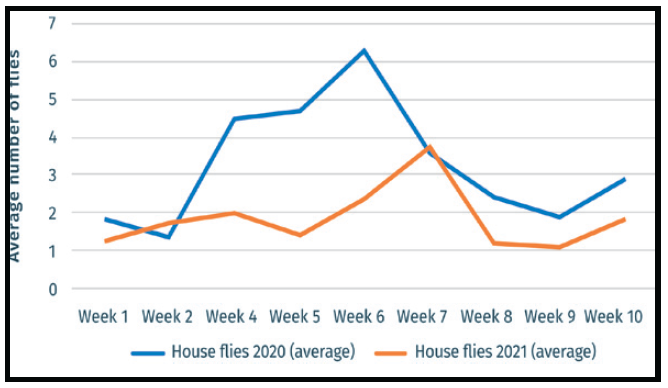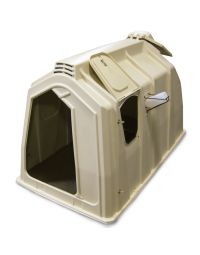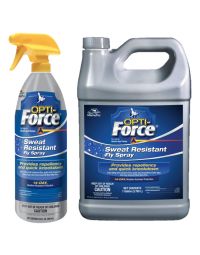Article courtesy of Elanco
House and stable flies are an annual problem on U.S. livestock operations as numbers can rapidly escalate during the summer months. This can have serious health, welfare and performance consequences for the animals and farm workers.
House flies (Musca domestica) can transmit over 100 pathogens including 65 that also affect humans1,2,3. These pathogens can cause economically important cattle diseases such as pink eye, mastitis, bacterial scours, typhoid, anthrax, vibriosis and clostridial diseases.
Stable flies (Stomoxys calcitrans) are blood feeders that reduce animal performance because they cause pain and fatigue as animals constantly strive to dislodge the flies4. These behaviors reduce feeding and resting time, resulting in reduced weight gain (up to 13 pounds in pre-weaned calves) and milk yield (up to 3.29lb./day)5. Stable flies also decrease feed conversion5 and can reduce growth rates by as much as 7.3%.6
Fly control requires an integrated approach
Effective fly control requires an integrated approach that includes good sanitation and hygiene practices to reduce potential breeding sites. Restricting feed spillages and water leaks will remove food for house flies and reduce the moist conditions favored by all fly larvae. Similarly, the correct application of the right fly control products, at the right time in the right place is an essential component of these control strategies.
Integrated adult and larval control treatments
Treatments for controlling house and stable flies include insecticides fatal to adult flies (adulticides) and others that disrupt the larval development stages (larvicides). Adulticides are applied as sprays to farm surfaces or, into the air as a “space spray”. Larvicides are applied to fly breeding areas such as wet manure, bedding and organic matter.
Efficacy of combined fly control program (calf hutches)
A ten-week fly control efficacy study was conducted on an Indiana calf rearing facility during the peak fly season months (May – September) of 2020 and repeated in 2021. The treatment program combined Neporex™ (cyromazine), a larvicide, with Agita™ (thiamethoxam) a fly adulticide. Each product was applied approximately every 3 weeks as follows:
• Neporex sprayed under the water and feed buckets in the hutches and along the fence
• Agita sprayed on the outside of the water/feed buckets, on the curtains and sides of hutches
To assess the efficacy of the fly control program, the number of stable flies found on 20 randomly selected calves was recorded every week during the 10-week peak fly season in both years. Similarly, the number of house flies found on the walls of 20 randomly selected calf hutches was also recorded for each of these weeks. The average number of stable flies found on the legs of the selected calves over the 10-week observation period ranged from 1.4 to 4.6 flies in 2020 and from 0.4 to 1.75 in 2021 (Figure 1).7
The average number of house flies found on the walls of selected calf hutches over the 10-week observation period ranged from 1.36 to 6.25 flies in 2020 and 1.08 to 3.75 in 2021 (Figure 2).7
Summary
• A combination of the Neporex (larvicide) and Agita (house fly adulticide) applied at 3-week intervals in calf hutches and pens proved highly effective for the control of both house and stable fly populations during consecutive fly seasons (2020 and 2021).
• In the years preceding 2020, regular space sprays had been required once or twice a week during the fly season in order to maintain adequate control.
1 Gestmann F et al. Flies as vectors of microorganisms potentially including severe diseases in humans and animals. From Mehlhorn H. Arthropods as vectors of emerging diseases. Parasitology Research Monograph, 2012; 9:195.
2 Forster M et al. Flies as Vectors of Parasites Potentially Inducing Severe Diseases in Humans and Animals. From Mehlhorn H. Arthropods as vectors of emerging diseases. Parasitology Research Monograph, 2012; 10:227.
3 Greenberg , B. “Flies and disease.“ Scientific American, 1965; 213 (1): 92-9.
4 Watson W, Waldron JK, Rutz DA. Integrated management of flies in and around dairy and livestock barns. Entomology, Cornell University. 1994. 102DMFS450.00. Available at: https://ecommons.cornell. edu/bitstream/handle/1813/42360/barnflies-FS-NYSIPM.pdf?sequence=1&isAllowed=y. Accessed Jan 21, 2019.
5 Gerry AC, Peterson NG, Mullens BA. Predicting and controlling stable flies on California dairies. University of California. 2007. Publication 8258. Available at: https://anrcatalog.ucanr.edu/pdf/8258.pdf. Accessed Feb 20, 2019.
6 Taylor, D. B., Moon, R. D., & Mark, D. R. Economic impact of stable flies (Diptera: Muscidae) on dairy and beef cattle production. Journal of Medical Entomology. 2012;49(1):198-209.
7 Elanco Animal Health. Data on file.
Agita, Neporex, Elanco and the diagonal bar logo are trademarks of Elanco or its affiliates. ©2022 Elanco. 22-ELA-0325. PM-US-22-0315.






![Agita 10 WG Fly Bait [2.2 lb.]](https://www.armoranimalhealth.com/media/catalog/product/cache/e914555b100ef56353ce6dd3a88e0faa/f/l/fly_bait.jpg)
![Neporex 2SG [11 lb.]](https://www.armoranimalhealth.com/media/catalog/product/cache/e914555b100ef56353ce6dd3a88e0faa/n/e/neporex_4.jpg)
![Neporex 2SG [11 lb.]](https://www.armoranimalhealth.com/media/catalog/product/cache/e62b29cbfd1c8a243018c6ffc350ffcf/n/e/neporex_4.jpg)
![Agita 10 WG Fly Bait [2.2 lb.]](https://www.armoranimalhealth.com/media/catalog/product/cache/e62b29cbfd1c8a243018c6ffc350ffcf/f/l/fly_bait.jpg)

![Tempo SC Ultra Pest Control Concentrate [32mL]](https://www.armoranimalhealth.com/media/catalog/product/cache/e62b29cbfd1c8a243018c6ffc350ffcf/2/3/23958_cylence_ultraconcentrate_front-facing.jpg)
